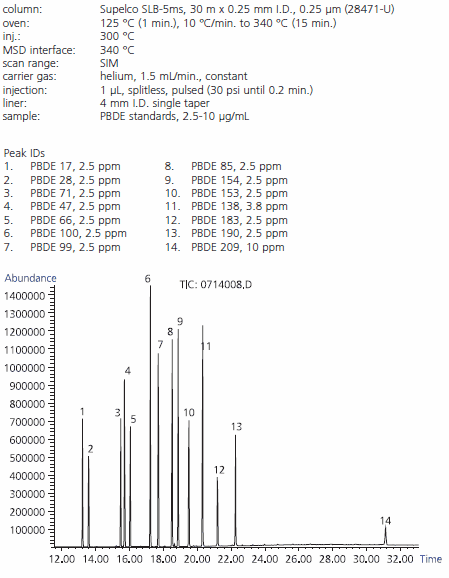GC Analysis of PBDE Flame-Retardant Compounds
Roberto Ferrari, Katherine Stenerson, Rainer Walz
Reporter EU Volume 21
Supelco SLB-5ms low-bleed capillary columns and PBDE analytical standards combine for efficient, reliable analysis of these compounds that are of increasing environmental concern.
Periodically, classes of compounds come under regulatory scrutiny: heavy metals, dioxins, pesticides and PCBs, for example. The attention is usually a result of published studies reporting toxicity, mass poisonings or wildlife kills, spills or site clean-up efforts. Gas chromatography (GC) is frequently used to monitor levels during the assessment and remediation processes, and in research aimed at developing safer alternatives.
Polybrominated diphenyl ethers (PBDEs) have recently become the focus of such scrutiny. These compounds are widely used as flame retardant additives in many consumer products including plastics, electronics, clothing, cushioning foams for furniture and automotive interiors. They slow ignition and rate of fire growth, allowing more time to escape from fires involving products to which they are added. According to the US EPA, world-wide demand in 2001 for two PBDE congeners, penta-BDE and octa- BDE, was estimated at 7,500,000 and 3,790,000 kg, respectively (US EPA, December 6, 2004 (69 FR 70404)).
Irrespective of the indisputable life- and property-saving value of these compounds, environmental studies indicate they exhibit persistence, toxicity and bioaccumulation. Because they are additives and not chemically bound within the product, PBDEs can and do leach into the environment (1, 2) and have been found everywhere, including household dust, landfill runoffs, ground and surface waters, sewage sludge, sediment, plants and animals, including humans. It is believed that their structural similarity to thyroid hormones is responsible for their wide spectrum of toxicity in laboratory animals, primarily developmental and neurological in nature (3, 4). As a result, the European community has changed its environmental regulations for the plastics industry, stating that the phase-out of all PBDEs in plastics, together with other toxic heavy metals such as lead, cadmium, mercury and hexavalent chromium, will commence on January 1, 2006. The US EPA proposed a rule in December of 2004 that as of Jan. 1, 2005, all manufacturers and importers would be required to notify the EPA at least 90 days in advance before starting the manufacture or import of certain PBDEs. A well-defined analytical method is critical to the efficient monitoring of PBDEs and includes high quality PBDE standards and a separation and detection technique, which is most often GC-MS or GC-ECD. Sigma-Aldrich, as a leading supplier of chromatography consumables to the environmental market, answered this need by providing quantitative standards of the PBDE congeners and Supelco SLB™-5ms capillary GC columns. Figure 1 shows the separation of PBDEs on the SLB- 5ms column. This mix contains fourteen of the most commonly found PBDE congeners.

Figure 1. Polybrominated diphenyl ethers by GC-MS 28471-U
Two features of the separation are noteworthy. First, the absence of column bleed and subsequent high signal-to-noise ratio, even at the analysis temperature of 340 °C, is a direct result of the SLB-5ms silphenylene polymer chemistry and facilitates low level detection. Unlike traditional methyl silicone based polymers, silphenylene polymers incorporate a phenyl group into the backbone structure. This increases the stability of the polymer by causing steric hindrance of the backbiting-scission reaction that leads to phase degradation and column bleed. Additionally, the polymers used in the SLB-5ms undergo extensive cross-linking, further reinforcing the stability of the bonded phase.
The second important feature is the excellent peak shape and response of the PBDE congeners tested on the SLB-5ms column. This is a critical requirement for trace level detection. The inertness of the SLB-5ms column is a result of the pre-treatment of the fused silica, which includes a proprietary deactivation technique.
Both the PDBE analytical standards and the Supelco SLB-5ms capillary GC column are examples of Sigma-Aldrich’s commitment to offer practical, innovative and high-quality solutions for environmental applications. For more information on these products, please call or visit our website: www.sigmaaldrich.com
Supelco SLB-5ms characteristics:
Phase: Bonded and highly cross-linked; silphenylene polymer virtually equivalent in polarity to 5% phenyl polymethylsiloxane
Operating Conditions: Chemically compatible with water and other injection solvents. Sensitive to strong inorganic acids and bases. Stable to low levels of HCl in non-aqueous samples. Not damaged by organic acids or bases. Columns can be rinsed.
Temperature Limits: 0.20 to 0.32 mm I.D. columns: -60 °C to 340 °C (isothermal) / 360 °C (programmable)
Guard Columns: We recommend fused silica guard columns to protect the analytical column from damage by sample components. The deactivation should be chosen to match the polarity of the injection solvent.
This column meets USP G27 and G36 requirements.
References
Per continuare a leggere, autenticati o crea un account.
Non hai un Account?